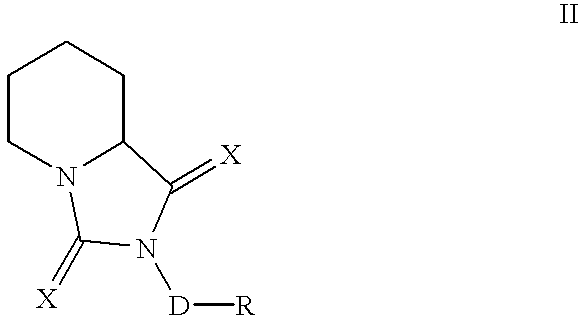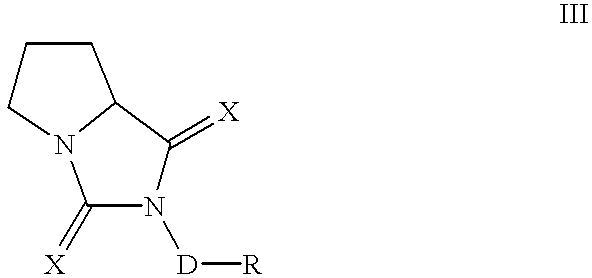Hydantoin derivative compounds, pharmaceutical compositions, and methods of using same
a technology of hydantoin and derivative compounds, which is applied in the field of hydantoin and hydantoin derivative compounds, can solve the problems of affecting the clinical application of these proteins in various neurological disease states, immunosuppressants exhibit a number of potentially serious side effects, and the mechanism of hair loss is very complicated, so as to promote hair growth, improve vision, and enhance memory performan
- Summary
- Abstract
- Description
- Claims
- Application Information
AI Technical Summary
Benefits of technology
Problems solved by technology
Method used
Image
Examples
example 1
Synthesis of 2-phenyl-2,5,6,7,8,8a-hexahydro-2-azaindolizine-1,3-dione
[0235]A solution of L-pipecolic acid methyl ester (1.0 g; 3.58 mmol), phenylisocyanate (0.42 ml; 3.93 mmol), and triethylamine (1.64 ml; 11.8 mmol) in methylene chloride (15 ml) was stirred overnight at room temperature. The solvent was removed under vacuum, the residue was dissolved in 50 ml of 50% ethyl acetate in hexane, and the organic phase was washed with water and brine, dried, and concentrated. The residue was purified on a flash column, eluting with 40% ethyl acetate in hexane, to obtain the product as a white solid, 1H NMR (MeOH, 400 MHz): δ 1.47-1.57 (cm, 3H); 1.62 (bd, 1H, J=9.99); 2.01 (bd, 1H, J=10.36); 2.20 (bd, 1H, J=9.88); 2.96 (t, 1H, J=9.35); 4.06-4.17 (m, 2H); 7.35-7.40 (m, 3H); 7.45-7.48 (m, 2H). Anal. Calcd. for: C, 67.81; H, 6.13; N, 12.17. Found: C, 67.93; H, 6.15; N, 12.21. Mp=186.1-186.7° C.
example 2
Synthesis of 2-(2-phenylethyl)-3-thioxo-2,5,6,7,7a-pentahydro-2-azapyrrolizin-1-one
[0236]A solution of L-proline methyl ester (1.0 g; 6.03 mmol), phenethylisothiocyanate (1.08 ml; 6.63 mmol), and triethylamine (2 ml; 15.07 mmol) in 15 ml of methylene chloride was stirred overnight at room temperature. The reaction was worked up as described previously, and the product purified to deliver a white solid, 1H NMR (CDCl3, 400 MHz): δ 1.56-1.62 (m, 1H); 2.10-2.26 (m, 3H); 2.96-3.01 (m, 2H); 3.52-3.58 (m, 1H); 3.92-3.99 (m, 3H); 4.00-4.12 (m, 1H); 7.19-7.31 (m, 5H). Anal. Calcd. for: C, 64.59; H, 6.19; N, 10.76; S, 12.32. Found: C, 64.69; H, 6.13; N, 10.71; S, 12.44. Mp=61.2-63.5° C.
example 3
2-(3-phenylpropyl)-3-thioxo-2,5,6,7,7a-pentahydro-2-azapyrrolizin-1-one
[0237]This example was prepared according to the method previously described. 1H NMR (CDCl3, 400 MHz): δ 1.60-1.63 (m, 1H); 2.00-2.06 (m, 2H); 2.12-2.18 (m, 1H); 2.20-2.26 (m, 2H); 2.66 (t, 2H, J=7.65); 3.51-3.57 (m, 1H); 3.80-3.85 (m, 2H); 3.90-3.97 (m, 1H); 4.07-4.12 (m, 1H); 7.15-7.25 (m, 5H). Anal. Calcd. for: C, 65.66; H, 6.61; N, 10.21; S, 11.69. Found: C, 65.66; H, 6.56; N, 10.14; S, 11.71.
PUM
| Property | Measurement | Unit |
|---|---|---|
| Molar density | aaaaa | aaaaa |
| Molar density | aaaaa | aaaaa |
| Fraction | aaaaa | aaaaa |
Abstract
Description
Claims
Application Information
 Login to View More
Login to View More - R&D
- Intellectual Property
- Life Sciences
- Materials
- Tech Scout
- Unparalleled Data Quality
- Higher Quality Content
- 60% Fewer Hallucinations
Browse by: Latest US Patents, China's latest patents, Technical Efficacy Thesaurus, Application Domain, Technology Topic, Popular Technical Reports.
© 2025 PatSnap. All rights reserved.Legal|Privacy policy|Modern Slavery Act Transparency Statement|Sitemap|About US| Contact US: help@patsnap.com



